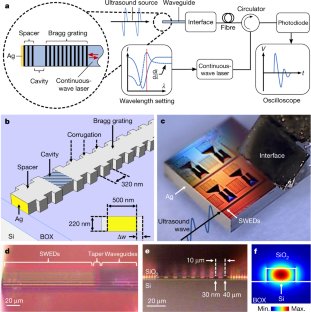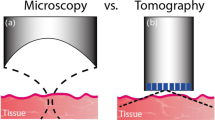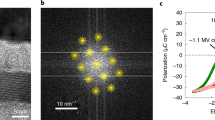Abstract
Ultrasound detectors use high-frequency sound waves to image objects and measure distances, but the resolution of these readings is limited by the physical dimensions of the detecting element. Point-like broadband ultrasound detection can greatly increase the resolution of ultrasonography and optoacoustic (photoacoustic) imaging1,2, but current ultrasound detectors, such as those used for medical imaging, cannot be miniaturized sufficiently. Piezoelectric transducers lose sensitivity quadratically with size reduction3, and optical microring resonators4 and Fabry–Pérot etalons5 cannot adequately confine light to dimensions smaller than about 50 micrometres. Micromachining methods have been used to generate arrays of capacitive6 and piezoelectric7 transducers, but with bandwidths of only a few megahertz and dimensions exceeding 70 micrometres. Here we use the widely available silicon-on-insulator technology to develop a miniaturized ultrasound detector, with a sensing area of only 220 nanometres by 500 nanometres. The silicon-on-insulator-based optical resonator design provides per-area sensitivity that is 1,000 times higher than that of microring resonators and 100,000,000 times better than that of piezoelectric detectors. Our design also enables an ultrawide detection bandwidth, reaching 230 megahertz at −6 decibels. In addition to making the detectors suitable for manufacture in very dense arrays, we show that the submicrometre sensing area enables super-resolution detection and imaging performance. We demonstrate imaging of features 50 times smaller than the wavelength of ultrasound detected. Our detector enables ultra-miniaturization of ultrasound readings, enabling ultrasound imaging at a resolution comparable to that achieved with optical microscopy, and potentially enabling the development of very dense ultrasound arrays on a silicon chip.
This is a preview of subscription content, access via your institution
Access options
Access Nature and 54 other Nature Portfolio journals
Get Nature+, our best-value online-access subscription
$29.99 / 30 days
cancel any time
Subscribe to this journal
Receive 51 print issues and online access
$199.00 per year
only $3.90 per issue
Buy this article
- Purchase on Springer Link
- Instant access to full article PDF
Prices may be subject to local taxes which are calculated during checkout




Similar content being viewed by others
Data availability
The data that support the findings of this study are available from the corresponding authors on reasonable request.
Code availability
The code used to analyse the data is available from the corresponding authors on reasonable request.
References
Ntziachristos, V. Going deeper than microscopy: the optical imaging frontier in biology. Nat. Methods 7, 603–614 (2010).
Wang, L. V. & Yao, J. A practical guide to photoacoustic tomography in the life sciences. Nat. Methods 13, 627–638 (2016).
Wissmeyer, G., Pleitez, M. A., Rosenthal, A. & Ntziachristos, V. Looking at sound: optoacoustics with all-optical ultrasound detection. Light Sci. Appl. 7, 53 (2018).
Zhang, C., Chen, S. L., Ling, T. & Guo, L. J. Review of imprinted polymer microrings as ultrasound detectors: design, fabrication, and characterization. IEEE Sens. J. 15, 3241–3248 (2015).
Guggenheim, J. A. et al. Microresonators for ultrasound sensing. Nat. Photon. 11, 714–719 (2017).
Khuri-Yakub, B. T. & Oralkan, Ö. Capacitive micromachined ultrasonic transducers for medical imaging and therapy. J. Micromech. Microeng. 21, 54004–54014 (2011).
Qiu, Y. et al. Piezoelectric micromachined ultrasound transducer (PMUT) arrays for integrated sensing, actuation and imaging. Sensors 15, 8020–8041 (2015).
Shnaiderman, R. et al. Fiber interferometer for hybrid optical and optoacoustic intravital microscopy. Optica 4, 1180–1187 (2017).
Rosenthal, A., Razansky, D. & Ntziachristos, V. High-sensitivity compact ultrasonic detector based on a pi-phase-shifted fiber Bragg grating. Opt. Lett. 36, 1833–1835 (2011).
Rosenthal, A. et al. Embedded ultrasound sensor in a silicon-on-insulator photonic platform. Appl. Phys. Lett. 104, 021116 (2014).
Dong, B. et al. Isometric multimodal photoacoustic microscopy based on optically transparent micro-ring ultrasonic detection. Optica 2, 169–176 (2015).
Jathoul, A. P. et al. Deep in vivo photoacoustic imaging of mammalian tissues using a tyrosinase-based genetic reporter. Nat. Photon. 9, 239–246 (2015).
Wang, X. et al. Narrow-band waveguide Bragg gratings on SOI wafers with CMOS-compatible fabrication process. Opt. Express 20, 15547–15558 (2012).
Lockwood, D. J. & Pavesi, L. (eds) Silicon Photonics II. Components and Integration Ch. 1 (Springer, 2011).
Royer, D. & Dieulesaint, E. Elastic Waves in Solids I. Free and Guided Propagation Ch. 5 (Springer, 2000).
Xu, M. & Wang, L. V. Analytic explanation of spatial resolution related to bandwidth and detector aperture size in thermoacoustic or photoacoustic reconstruction. Phys. Rev. E 67, 056605 (2003).
Ash, E. A. & Nicholls, G. Super-resolution aperture scanning microscope. Nature 237, 510–512 (1972).
Harootunian, A., Betzig, E., Isaacson, M. & Lewis, A. Super-resolution fluorescence near-field scanning optical microscopy. Appl. Phys. Lett. 49, 674–676 (1986).
Huang, F. M. & Zheludev, N. I. Super-resolution without evanescent waves. Nano Lett. 9, 1249–1254 (2009).
Li, J., Fok, L., Yin, X., Bartal, G. & Zhang, X. Experimental demonstration of an acoustic magnifying hyperlens. Nat. Mater. 8, 931–934 (2009).
Zhu, J. et al. A holey-structured metamaterial for acoustic deep-subwavelength imaging. Nat. Phys. 7, 52–55 (2011).
Omar, M., Aguirre, J. & Ntziachristos, V. Optoacoustic mesoscopy for biomedicine. Nat. Biomed. Eng. 3, 354–370 (2019).
Li, H., Dong, B., Zhang, Z., Zhang, H. F. & Sun, C. A transparent broadband ultrasonic detector based on an optical micro-ring resonator for photoacoustic microscopy. Sci. Rep. 4, 4496 (2015).
Rosenthal, A. et al. Sensitive interferometric detection of ultrasound for minimally invasive clinical imaging applications. Laser Photonics Rev. 8, 450–457 (2014).
Gao, F., Wang, Y., Cao, G., Jia, X. & Zhang, F. Reduction of sidewall roughness in silicon-on-insulator rib waveguides. Appl. Surf. Sci. 252, 5071–5075 (2006).
Bogaerts, W. & Selvaraja, S. K. Compact single-mode silicon hybrid rib/strip waveguide with adiabatic bends. IEEE Photonics J. 3, 422–432 (2011).
Huang, X. et al. A high-frequency transimpedance amplifier for CMOS integrated 2D CMUT array towards 3D ultrasound imaging. In Proc. Annual International Conference of the IEEE Engineering in Medicine and Biology Society (EMBS) (eds Hielscher, A. & Liu, S.) 101–104 (IEEE, 2013).
Hajireza, P., Shi, W., Bell, K., Paproski, R. J. & Zemp, R. J. Non-interferometric photoacoustic remote sensing microscopy. Light Sci. Appl. 6, e16278 (2017).
Pelivanov, I., Buma, T., Xia, J., Wei, C. & Donnell, M. O. A new fiber-optic non-contact compact laser-ultrasound scanner for fast non-destructive testing and evaluation of aircraft composites. J. Appl. Phys. 115, 113105 (2014).
Pelivanov, I. et al. High resolution imaging of impacted CFRP composites with a fiber-optic laser-ultrasound scanner. Photoacoustics 4, 55–64 (2016).
Sacher, W. D. et al. Monolithically integrated multilayer silicon nitride-on-silicon waveguide platforms for 3-D photonic circuits and devices. Proc. IEEE 106, 2232–2245 (2018).
Krishnamoorthy, A. V. et al. Exploiting CMOS manufacturing to reduce tuning requirements for resonant optical devices. IEEE Photonics J. 3, 567–579 (2011).
Michel, J., Liu, J. & Kimerling, L. C. High-performance Ge-on-Si photodetectors. Nat. Photon. 4, 527–534 (2010).
Shen, Y. et al. Deep learning with coherent nanophotonic circuits. Nat. Photon. 11, 441–446 (2017).
Rosenthal, A., Razansky, D. & Ntziachristos, V. Wideband optical sensing using pulse interferometry. Opt. Express 20, 19016–19029 (2012).
Selvaraja, S. K., Bogaerts, W., Dumon, P., Van Thourhout, D. & Baets, R. Subnanometer linewidth uniformity in silicon nanophotonic waveguide devices using CMOS fabrication technology. IEEE J. Sel. Top. Quantum Electron. 16, 316–324 (2010).
Wang, L. V. & Hu, S. Photoacoustic tomography: in vivo imaging from organelles to organs. Science 335, 1458–1462 (2012).
Tzoumas, S. et al. Eigenspectra optoacoustic tomography achieves quantitative blood oxygenation imaging deep in tissues. Nat. Commun. 7, 12121 (2016).
Taruttis, A. & Ntziachristos, V. Advances in real-time multispectral optoacoustic imaging and its applications. Nat. Photon. 9, 219–227 (2015).
Sang, S. et al. Progress of new label-free techniques for biosensors: a review. Crit. Rev. Biotechnol. 36, 465–481 (2016).
Diekmann, R. et al. Chip-based wide field-of-view nanoscopy. Nat. Photon. 11, 322–328 (2017).
Shacham-Diamand, Y., Inberg, A., Sverdlov, Y. & Croitoru, N. Electroless silver and silver with tungsten thin films for microelectronics and microelectromechanical system applications. J. Electrochem. Soc. 147, 3345–3349 (2000).
Van Laere, F. et al. Compact focusing grating couplers between optical fibers and silicon-on-insulator photonic wire waveguides. In Proc. Conference on Optical Fiber Communication and the National Fiber Optic Engineers Conference (OFC/NFOEC) (ed. Li, C.) 1–3 (IEEE, 2007).
Strohm, E. M., Berndl, E. S. L. & Kolios, M. C. High frequency label-free photoacoustic microscopy of single cells. Photoacoustics 1, 49–53 (2013).
Köstli, P. K., Martin, F., Hans, B. & Heinz, W. P. Temporal backward projection of optoacoustic pressure transients using Fourier transform methods. Phys. Med. Biol. 46, 1863–1872 (2001).
Mellen, R. H. The thermal-noise limit in the detection of underwater acoustic signals. J. Acoust. Soc. Am. 24, 478–480 (1952).
Acknowledgements
We thank D. Razansky, H. Estrada, R. J. Wilson, C. Zakian and A. Rosenthal for comments and discussions. We thank the staff at IMEC (Leuven, Belgium), ePIXfab (Ghent, Belgium) and Ara Coatings (Erlangen, Germany) for technical expertise at various steps during the manufacturing process. We acknowledge financial support from the European Research Council (ERC) under the European Union’s Horizon 2020 research and innovation programme under grant agreement numbers 694968 (PREMSOT), 667933 (MIB) and 732720 (ESOTRAC), and from the Deutsche Forschungsgemeinschaft (DFG; Gottfried Wilhelm Leibniz Prize 2013; NT 3/10-1).
Author information
Authors and Affiliations
Contributions
R.S. conceived the SWED and its principle of operation, and designed the chip layout. R.S. and G.W. constructed the first SWED prototype. R.S. and O.Ü. performed experimental work leading to the demonstration of imaging performance and detector resolution. O.Ü. polished, coated and connectorized the chips. R.S. and V.N. designed experiments, and R.S. and O.Ü. conducted the imaging experiments. R.S. processed and analysed the data. Q.M. developed the image reconstruction algorithm and contributed to image processing. A.C. advised on the experimental setup and constructed the optical confocal microscope. R.S. and V.N. wrote the manuscript. V.N. supervised the research. All authors read and edited the manuscript.
Corresponding authors
Ethics declarations
Competing interests
V.N. has financial interests in iThera Medical GmbH, Surgvision BV/Bracco S.p.A, I3 Inc. and Spear UG.
Additional information
Peer review information Nature thanks Ivan Pelivanov and the other, anonymous, reviewer(s) for their contribution to the peer review of this work.
Publisher’s note Springer Nature remains neutral with regard to jurisdictional claims in published maps and institutional affiliations.
Extended data figures and tables
Extended Data Fig. 1 Process control with spectral response.
a–c, Monitoring the reflection spectrum of a SWED with Δw = 40 nm (SWED340nm) during the polishing process of the SOI chip: before the start of polishing (a); at the end of polishing and before the application of the Ag coating (b); and after the application of the Ag coating (c).
Extended Data Fig. 2 Schematics of the experimental setups.
a, Characterization setup. An inverted microscope is coupled to a laser source for optoacoustic excitation; the SOI chip (CH) is mounted in a trans-illumination geometry and is raster-scanned over the sample placed on the coverslip (CS) (stages not shown). b, Imaging setup. The laser source for optoacoustic excitation is coupled into an optical fibre, which illuminates the sample; the chip is mounted in a reflection-mode illumination geometry. The coverslip holding the sample is raster-scanned while the chip and the illumination fibre (IF) are stationary (stages not shown). In both setups, the SWED interrogation is performed by a tuneable continuous-wave laser. OBJ, microscope objective.
Extended Data Fig. 3 Long-term detection stability of the SWED.
The variation in the maximum values of the detected signal amplitude is shown over 15 min. BPF, band-pass filter; a.u., arbitrary units.
Extended Data Fig. 4 Hydrophone and SWED responses to an acoustic point source over the frequency band [2, 500] MHz.
The hydrophone response has been scaled up by a factor of 30 for visibility. Signals attributed to reflections between the SWED and the sample holder are indicated.
Supplementary information
Supplementary Information
This file contains Supplementary Notes on Sensitivity.
Rights and permissions
About this article
Cite this article
Shnaiderman, R., Wissmeyer, G., Ülgen, O. et al. A submicrometre silicon-on-insulator resonator for ultrasound detection. Nature 585, 372–378 (2020). https://doi.org/10.1038/s41586-020-2685-y
Received:
Accepted:
Published:
Issue Date:
DOI: https://doi.org/10.1038/s41586-020-2685-y
This article is cited by
-
Polydimethylsiloxane (PDMS) Coated Broadband Tunable Vanadium Dioxide (VO2) Based Linear Optical Cavity Temperature Sensor
Sensing and Imaging (2024)
-
Highly sensitive ultrasound detection using nanofabricated polymer micro-ring resonators
Nano Convergence (2023)
-
300-Gbps optical interconnection using neural-network based silicon microring modulator
Communications Engineering (2023)
-
Massively parallel electro-optic sampling of space-encoded optical pulses for ultrafast multi-dimensional imaging
Light: Science & Applications (2023)
-
Parallel interrogation of the chalcogenide-based micro-ring sensor array for photoacoustic tomography
Nature Communications (2023)
Comments
By submitting a comment you agree to abide by our Terms and Community Guidelines. If you find something abusive or that does not comply with our terms or guidelines please flag it as inappropriate.



